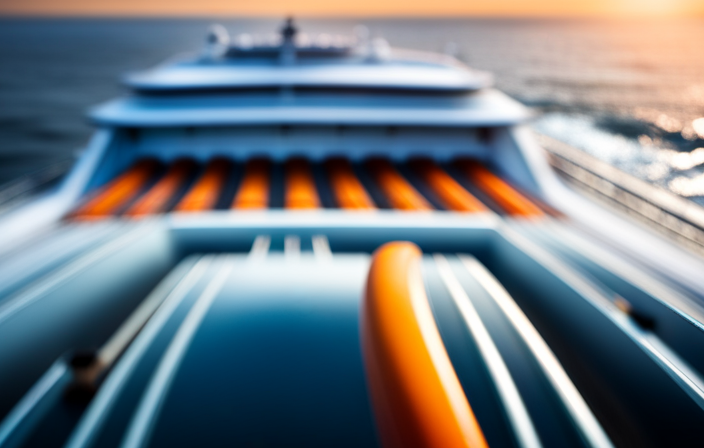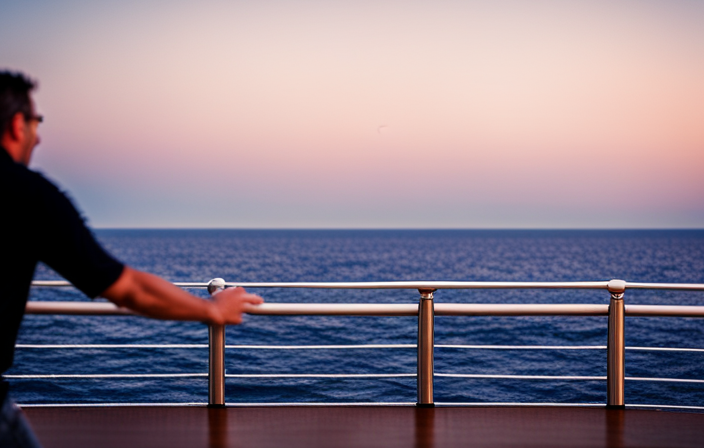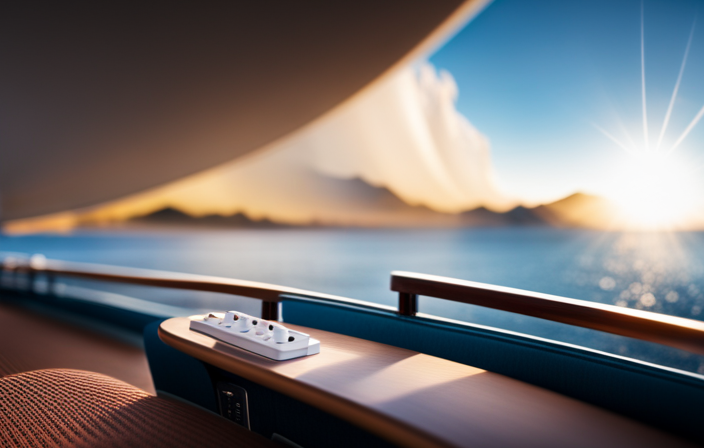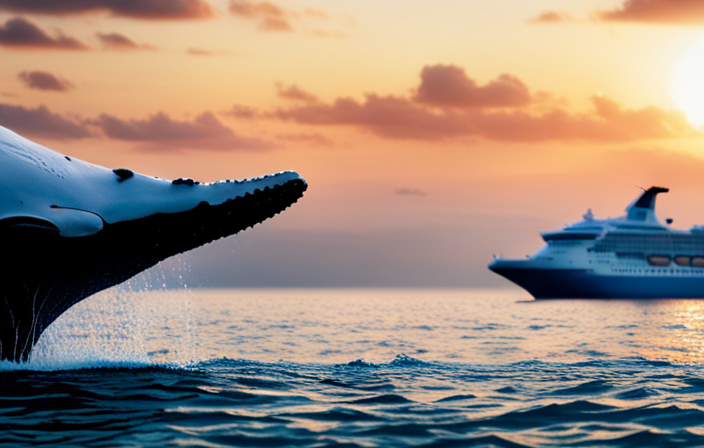Embarking on my maiden voyage on a cruise ship, my thoughts were consumed with concerns regarding the safety protocols aboard. A pressing question that persisted was regarding the quantity of lifeboats present on a cruise ship. Seeking clarification, I explored the regulations set forth by the International Maritime Organization (IMO) and uncovered a realm filled with complex and captivating information.
According to these regulations, the number of lifeboats required depends on various factors such as ship size and passenger capacity. For instance, a typical large cruise liner might have around 20 lifeboats with each accommodating approximately 150 people. However, it’s important to note that this number can vary based on specific safety requirements.
To ensure that passengers are well-prepared for any emergency situation, strict safety regulations mandate regular drills and crew training. These initiatives aim to enhance passenger safety by familiarizing everyone with proper procedures during an evacuation.
In this article, we will explore the different factors affecting lifeboat capacity on cruise ships and delve into industry initiatives towards improving overall safety standards. Join me as we navigate through this technical landscape to better understand how cruise ships prioritize passenger well-being.
Key Takeaways
- Lifeboats are launched from different positions on the ship.
- Regular maintenance and inspections are essential for lifeboat safety.
- Inflatable slides and marine escape chutes are alternative emergency evacuation measures.
- Liferafts and marine escape chutes provide rapid evacuation from higher decks.
International Maritime Organization (IMO) Regulations on Lifeboat Capacity
Cruise ships are required to adhere to International Maritime Organization (IMO) regulations on lifeboat capacity. These regulations ensure the safety of passengers and crew members in emergencies. Lifeboat capacity standards are based on factors such as ship size and type, as well as the number of people onboard. The IMO specifies the minimum number of lifeboats and their maximum capacity for each cruise ship. This ensures that there are enough lifeboats for everyone in case of evacuation. These regulations are crucial for the safety and well-being of individuals at sea. Now, let’s explore the standard lifeboat capacity for different types of cruise ships.
Standard Lifeboat Capacity for Different Types of Cruise Ships
Cruise ships have a standardized capacity for lifeboats based on their type. According to international regulations, safety requirements dictate that cruise ships must have enough lifeboats to accommodate all passengers and crew on board. The standard lifeboat capacity varies depending on the size and type of the ship.
For small cruise ships with up to 500 passengers, the typical minimum requirement is four fully enclosed lifeboats with a capacity of 150 persons each.
Medium-sized cruise ships, carrying between 500 and 1,000 passengers, are required to have six fully enclosed lifeboats, each capable of accommodating 150 persons.
Large cruise ships with more than 1,000 passengers must have at least eight fully enclosed lifeboats with a capacity of 150 persons each.
These regulations ensure that there are enough life-saving resources available in case of an emergency at sea.
Moving forward into the factors affecting lifeboat capacity section…
Factors Affecting Lifeboat Capacity
One key factor affecting lifeboat capacity is the size and type of the vessel. The larger the ship, the more lifeboats it can accommodate. Additionally, different types of cruise ships may have varying designs that impact lifeboat capacity. For example, some ships have dedicated spaces on deck for storing lifeboats, while others may have limited space due to amenities or structural limitations.
Other factors that can affect lifeboat capacity include regulations set by maritime authorities. These regulations dictate the minimum number of lifeboats required based on factors such as ship size and passenger capacity.
It is important to note that while lifeboats are a common means of emergency evacuation on cruise ships, there are also alternative measures in place. These measures can include inflatable rafts, marine evacuation systems, or even transferring passengers to nearby vessels in case of an emergency.
Moving forward into the next section about ship size and passenger capacity…
Ship Size and Passenger Capacity
When considering the size of a vessel and the number of passengers it can accommodate, it is essential to take into account the overall dimensions and passenger capacity.
Ship dimensions play a crucial role in determining the number of lifeboats that can be accommodated on board. Larger ships usually have more space available for lifeboats compared to smaller ones.
Additionally, passenger demographics also influence lifeboat capacity. Ships carrying a larger number of passengers will require more lifeboats to ensure everyone’s safety in case of an emergency. Factors such as age groups, physical abilities, and special needs among passengers must be considered when determining the required number of lifeboats.
These considerations are vital to comply with safety regulations and requirements, which aim to protect all individuals on board in any unforeseen circumstances without compromising their well-being or security.
Safety Regulations and Requirements
Passenger safety is a top priority for maritime authorities. Regulations require vessels to have a specific ratio of life-saving equipment to the number of people on board. Cruise ships must carry an adequate number of lifeboats to accommodate all passengers and crew members in case of emergencies. Lifeboat capacity standards are determined based on factors such as the ship’s size and passenger capacity. These standards ensure that there are enough lifeboats available to evacuate everyone safely in the event of an emergency.
In addition to lifeboats, cruise ships are also required to have other emergency response plans in place. These plans outline procedures for evacuating the ship, coordinating with rescue services, and providing medical assistance if needed. Cruise lines work closely with regulatory bodies to develop comprehensive emergency preparedness plans that meet or exceed industry standards.
Transitioning into the subsequent section about ’emergency preparedness plans’, it is crucial for cruise ships to be well-equipped with not only life-saving equipment but also effective strategies and protocols for handling emergencies at sea.
Emergency Preparedness Plans
In order to ensure the safety of everyone on board, maritime authorities require that vessels have well-developed emergency preparedness plans in place. These plans include alternative evacuation methods and passenger safety measures to be implemented in case of an emergency situation.
One such method is the use of life rafts as an alternative means of evacuation when lifeboats are not available or cannot be deployed. Life rafts are designed to accommodate a certain number of passengers and are equipped with survival equipment such as food, water, and signaling devices.
Additionally, emergency drills and training exercises are conducted regularly to prepare both crew members and passengers for potential emergencies. These drills cover various scenarios, including fire incidents, abandon ship procedures, and medical emergencies.
By having comprehensive emergency preparedness plans in place, cruise ships can effectively respond to any unforeseen situations that may arise during a voyage.
Transitioning into the subsequent section about ‘lifeboat deployment and training procedures’, it is crucial for cruise ship personnel to be knowledgeable about the proper methods for deploying lifeboats during emergencies.
Lifeboat Deployment and Training Procedures
To properly ensure the safety of everyone on board, it’s important for you to understand the correct procedures for deploying lifeboats in case of an emergency. Lifeboat deployment techniques and crew training methods play a critical role in ensuring an efficient and effective response during a crisis at sea.
During crew training, we focus on teaching the proper sequence of actions to deploy lifeboats swiftly. This includes familiarizing ourselves with the boat’s layout, locating the release mechanisms, and understanding how to safely lower the lifeboat into the water. Additionally, we practice launching lifeboats from different positions on the ship and simulate various emergency scenarios.
By following these procedures, our crew can quickly respond to emergencies and efficiently evacuate passengers if necessary. Now that you understand how lifeboats are deployed, let’s delve into another crucial aspect of ensuring their functionality: lifeboat maintenance and inspections.
Lifeboat Maintenance and Inspections
Regular maintenance and inspections are essential for the functionality and readiness of lifeboats in case of emergencies. These procedures ensure the safety of both passengers and crew members on a cruise ship. Inspections should be conducted regularly to identify any signs of damage or wear, such as cracks, leaks, or faulty equipment. A comprehensive lifeboat inspection checklist should be followed, covering the condition of the hull, propulsion system, electrical components, and communication devices. In addition to inspections, regular maintenance tasks are necessary. These tasks include greasing moving parts, testing engine performance, and replacing worn-out parts. Adhering to these procedures guarantees that lifeboats are always in optimal condition for swift deployment when needed.
Alternative Emergency Evacuation Measures
Another option for emergency evacuation is to explore alternative measures that can be implemented in addition to lifeboats on a cruise ship. With technological advancements, there are now alternative evacuation methods available that can provide additional safety and efficiency during emergencies.
One such method is the use of inflatable slides or ramps that can be deployed from the upper decks of the ship to allow passengers to safely evacuate onto rescue vessels or life rafts. These slides are designed to be rapidly inflated and provide a quick and efficient means of evacuation.
Additionally, some cruise ships are equipped with marine escape chutes, which are enclosed tubes that allow passengers to slide down into life rafts or rescue boats below. These alternative measures enhance the overall emergency preparedness of a cruise ship, ensuring the safety and well-being of all passengers and crew members during any unforeseen events without relying solely on lifeboats for evacuation.
Transitioning into the subsequent section about liferafts and marine escape chutes…
Liferafts and Marine Escape Chutes
Liferafts and marine escape chutes are alternative emergency evacuation measures used on cruise ships. Liferafts are inflatable devices designed to accommodate a specific number of people in case of an emergency. Each liferaft has a predetermined capacity that is based on the ship’s passenger count. These rafts are equipped with survival equipment such as food, water, and signaling devices to ensure the safety of the occupants until rescue arrives.
On the other hand, marine escape chutes provide a rapid means of evacuation from higher decks to lifeboats or liferafts below. They consist of long tubes made from fire-resistant materials that allow passengers to slide down quickly and safely during emergency situations.
Transitioning into the subsequent section about helicopter rescue operations, these measures serve as vital components of comprehensive emergency evacuation procedures onboard cruise ships.
Helicopter Rescue Operations
Helicopter rescue operations are a crucial aspect of emergency evacuation measures on a cruise ship. These operations serve as an alternative method for evacuating passengers and crew members in situations where traditional means may not be feasible. Skilled professionals conduct these operations, following specific protocols to ensure the safety of all involved.
Cruise ships are equipped with helipads that provide suitable landing areas for helicopters, facilitating efficient rescues. Designated staff members receive specialized training in coordinating these complex operations.
To ensure passengers’ safety, it is essential that they receive thorough briefings on emergency procedures and participate in evacuation drills regularly.
Passenger Safety Briefings and Drills
Make sure you pay attention to the passenger safety briefings and participate in evacuation drills regularly to ensure your safety on board.
Passenger evacuation is a critical aspect of emergency response on a cruise ship. During the safety briefing, you will learn important information about the location of emergency exits, how to properly wear a life jacket, and what to do in case of an emergency. This knowledge is crucial for your own safety and that of others around you.
In addition to the safety briefing, participating in evacuation drills allows you to practice the necessary actions in a controlled setting. These drills simulate real-life situations and familiarize you with the procedures involved in evacuating the ship safely and efficiently. By actively engaging in these activities, you contribute to maintaining a high level of preparedness among passengers and crew members alike, ensuring everyone’s well-being on board.
Transitioning into the subsequent section about the importance of lifeboat drills and crew training, it is equally essential for crew members to undergo rigorous training programs that focus on lifeboat operations and rescue techniques.
Importance of Lifeboat Drills and Crew Training
Transitioning to the importance of lifeboat drills and crew training, it’s crucial for crew members to undergo rigorous training programs that focus on mastering lifeboat operations and rescue techniques. Crew competency is a vital aspect of ensuring the safety of passengers during emergency situations. Through regular evacuation simulations, crew members can develop the necessary skills and knowledge to effectively handle lifeboats and facilitate smooth evacuations. These drills involve practicing launching and maneuvering lifeboats, as well as conducting mock rescues and coordinating with other crew members. By familiarizing themselves with these procedures, crew members are better equipped to handle potential emergencies at sea.
To enhance the effectiveness of training programs, cruise ship companies often utilize industry initiatives aimed at improving lifeboat safety. These initiatives include implementing advanced technology in lifeboat systems, conducting comprehensive risk assessments, and continuously monitoring crew performance through audits and evaluations. Such efforts contribute to creating an environment where passenger safety is prioritized.
Industry Initiatives and Improvements in Lifeboat Safety
The safety of lifeboats has been significantly enhanced through industry initiatives and improvements.
Industry collaboration has played a crucial role in driving advancements in lifeboat safety. Cruise ship companies, regulatory bodies, and manufacturers have come together to develop innovative solutions that prioritize passenger protection.
Technological advancements have also contributed to the improvement of lifeboat safety. Newer lifeboats are equipped with state-of-the-art features such as self-righting capabilities, improved stability, and enhanced evacuation systems. These advancements ensure that passengers can evacuate quickly and safely in case of an emergency.
Furthermore, regular inspections and maintenance procedures are now implemented to guarantee the proper functioning of lifeboats at all times.
In the next section about ensuring passenger safety on cruise ships, we will explore additional measures taken by the industry for a comprehensive approach to safeguarding passengers’ well-being without repeating steps already mentioned.
Conclusion: Ensuring Passenger Safety on Cruise Ships
In conclusion, the collective efforts of industry stakeholders have paved the way for comprehensive measures that prioritize passenger safety and well-being on board cruise vessels. The importance of safety protocols cannot be overstated when it comes to ensuring passenger well-being.
Cruise ship operators now implement strict guidelines and regulations to guarantee the highest level of security for all passengers. These include regular training sessions for crew members on emergency procedures, routine maintenance checks for lifeboats, and improved communication systems to enhance response times during emergencies.
Additionally, cruise ships are equipped with state-of-the-art lifeboat systems that adhere to international safety standards. These initiatives aim to provide passengers with a safe and secure environment throughout their voyage.
By continually reviewing and enhancing safety measures, the cruise industry is committed to maintaining the utmost passenger well-being while onboard their ships.
Frequently Asked Questions
What are some alternative emergency evacuation measures that may be used on a cruise ship?
In the realm of cruise ship safety protocols, alternative evacuation methods serve as crucial backups. From inflatable slides to marine evacuation systems, these measures ensure passenger safety in emergency situations.
Are liferafts and marine escape chutes commonly used for emergency evacuations on cruise ships?
Liferafts and marine escape chutes are commonly used for emergency evacuations on cruise ships. Liferafts provide a quick and efficient means of escape, while marine escape chutes offer another option for passengers to safely evacuate the ship.
How often are lifeboats inspected and maintained on a cruise ship?
Lifeboats on cruise ships are inspected and maintained regularly to ensure safety. According to industry guidelines, inspections should be conducted at least once every three months, with maintenance including checks on equipment, hull integrity, and launching mechanisms.
What are the industry initiatives and improvements that have been made in lifeboat safety?
Industry initiatives and improvements in lifeboat safety have focused on enhancing design, construction, and maintenance standards. The implementation of advanced technologies, such as automatic release systems and improved training programs, has also played a crucial role in ensuring the safety of passengers and crew members.
How important are passenger safety briefings and drills in ensuring passenger safety on cruise ships?
Passenger safety briefings and drills are crucial for ensuring passenger safety on cruise ships. By actively participating in these exercises, passengers become familiar with emergency procedures and evacuation protocols, while crew training ensures efficient execution of such measures.
Conclusion
In conclusion, it’s truly remarkable how cruise ships prioritize passenger safety by ensuring an abundance of lifeboats. These floating wonders, with their luxurious amenities and breathtaking views, are also equipped with a sufficient number of life-saving vessels.
It’s almost comical to imagine these magnificent giants valuing the safety of their passengers above all else. But in reality, it is this attention to detail and commitment to safety regulations that make cruising an enjoyable experience for millions worldwide.
So rest assured, dear travelers, your voyage will be both opulent and secure.
Alfons is the visionary leader and driving force behind Voyager Info’s success. As the Editor in Chief, he brings a wealth of experience and an unwavering passion for travel to the helm of our cruise-centric platform.
With a lifelong fascination for exploring new horizons, Alfons discovered his love for the ocean and cruising at a young age. From sailing across pristine Caribbean waters to embarking on daring expeditions to far-flung destinations, he has amassed a treasure trove of first-hand experiences in the world of cruising.











